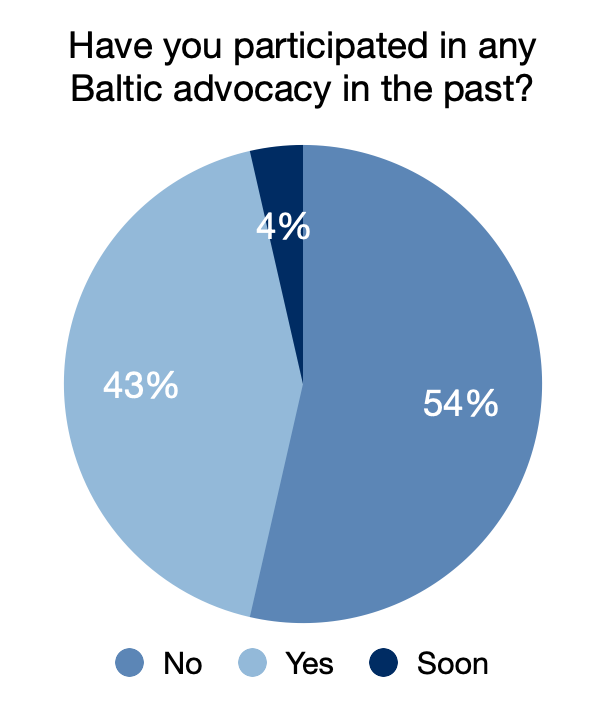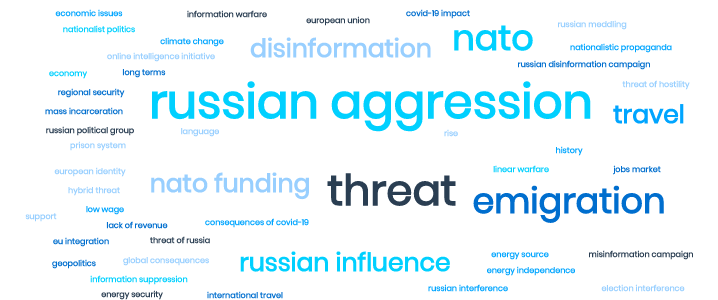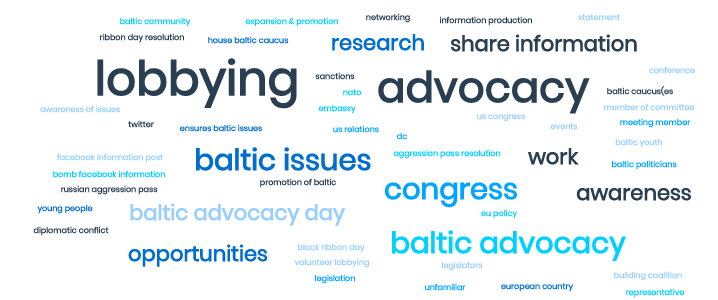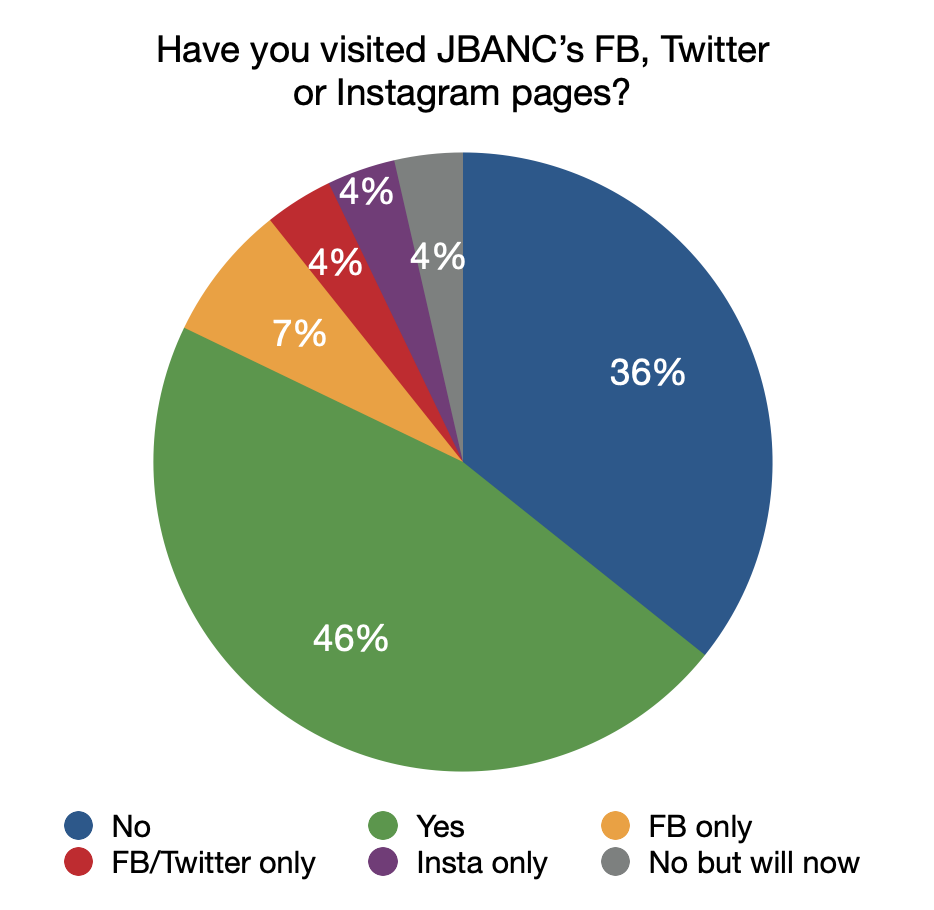Report contributed by Madelena Miniats
With the Baltic youth advocacy survey completed, a total of twenty-eight people participated from the United States and Canada, all of Estonian, Latvian or Lithuanian descent. The biggest takeaways were that young Balts are interested and ready to engage and participate in Baltic advocacy in their communities, but they need support from JBANC in doing so. More specifically, respondents said they need help in understanding the relevant issues, what their role could be, and what kind of impact they can make. They also expressed an interest in advocacy events, but said that covering travel expenses to such events can be difficult. In addition, there seems to be a slight disconnect between JBANC and young people. Though information is often shared through JBANC channels, such as social media accounts and newsletters, some of the information is difficult to grasp, or unattractive for young people who are not politically inclined. Respondents said that a JBANC information session, or a podcast specifically for young people, would be helpful to those interested in learning more.
Below are the highlights from the nineteen questions that were asked:

Do you think Baltic advocacy is important?
All respondents agreed that Baltic advocacy is important. One individual said that while it is important to support freedom and democracy in all countries, people often focus only on domestic affairs, and view international politics through a lens of American politics and diplomacy. Another respondent said that “American interests are rooted in Baltic issues, and those of us in Baltic communities must use our voice to amplify those of our Baltic countries.” To clarify, while American interests are not rooted in Baltic issues, both countries are currently facing similar issues in relation to democracy and governance.
If you have participated in Baltic advocacy, what influenced your decision to participate?
Respondents expressed that their need to participate stems from their passion for preserving their culture and heritage. Others expressed that they draw inspiration from freedom fighters who came before them. Some respondents specifically drew upon specific issues, such as the impact of election interference on democracy, the passivity of government and institutions, and the need for the Baltic nations to be present at policy discussions in DC. Others responded that their decision to participate in advocacy is influenced by their professional life, in which community organizing and advocacy is important for professional development.
If you haven’t participated in Baltic advocacy, what deterred you from participating or what made you feel you were unable to?
Two respondents specifically spoke to how Baltic advocacy in the US (and in Canada) has historically been “old boys club” that does not have an interest in creating an inviting atmosphere or space for youth. Another participant said they hadn’t felt passionate enough to advocate for a particular Baltic issue. Others expressed that they did not have accessibility to DC but would like to participate in other ways.
Can you name a relevant issue or concern that is currently facing the Baltic states?

All respondents were able to name at least one issue facing the Baltic states, most notably Russian aggression. Other relevant issues mentioned were the relationship between Estonian and Russian-speaking populations, European identity, the influence of pro-Russian political groups, lack of revenue from international travel due to COVID-19 and the rise of far-right and nationalist politics. Surprisingly, one respondent specifically referred to NATO funding in the Baltics. They mentioned Latvia has not paid its 2% [Latvia, like its Baltic neighbors, is now contributing 2% or more of its GDP on defense], and mentioned they supported the US troop withdrawal from Germany. Another unexpected answer addressed mass incarceration and how the prison system (specifically in Latvia) still mirrors the Soviet style prison system. One respondent said that it would beneficial to “look through an American lens” when discussing misinformation campaigns, targeted online intelligence initiatives, election interference and re-writing history.
What issues do you think are not being highlighted enough?

List some examples of the kind of work JBANC engages in.

If you are unfamiliar or have very little idea of their work, what do you think they do based on their name?
Most respondents understood the general idea about the work JBANC does: to advocate for and spread awareness of Baltic issues, while working with Members of Congress on Capitol Hill. This question was originally asked to see if any description of JBANC’s work needs to be clarified. In particular, two respondents said that JBANC encourages Americans to speak and vote on Baltic issues that are linked to US politics and work with American and Baltic politicians to better serve the Baltic states. More than one respondent mentioned working not only with US politicians but also Baltic politicians. One respondent said JBANC was “some kind of bank.”

If you have participated in Baltic Advocacy Day, what was the general idea? What did you like or dislike about your experience?
Not many respondents answered this question reflecting the 61% of respondents who said they have not participated. One respondent expressed that they enjoyed visiting their state representative and discussing Baltic issues. Another respondent said it was a great opportunity to network and to experience the coming together of people over a common goal to influence Congress.

If you have never heard of the event, what do you think the day is about based on the name?
Similarly to the question about JBANC’s work, most individuals were able to form a general idea of the goal of Baltic Advocacy Day. In addition to promoting advocacy and Baltic issues, some respondents said it was a day of parades, events and rallies to spread awareness of Baltic affairs as well as advocating for Baltic freedom and economic stimulation and growth.
If you have had an interest in participating, but have not, what factors limited your ability to participate?

What resources would be beneficial in spreading awareness of the aforementioned advocacy projects and organizations? What do you think is missing?
Respondents had a lot of ideas about how to more effectively spread awareness of advocacy projects and organizations. One respondent said that it would be beneficial for a JBANC representative to attend events throughout the year to explain the mission of not just JBANC but also Baltivist and Baltic Advocacy Day. Another respondent mentioned organizing a virtual event that would allow people who do not live in DC to participate, provide an opportunity to ask questions and a “letter writing initiative.” Another individual expressed the importance of social media branding and having “key people take over” the JBANC Instagram page to spread critical information. The overall summary was to maintain a stronger social media presence and “stand out from all the noise.”

It’s sometimes hard for some to find incentive in advocacy work. What would incentivize you and your friends to participate more frequently in Baltic advocacy work?
The general takeaway is that more needs to be done to educate youth on the basics of advocacy and they feel it is JBANC’s role to do that. If they feel more confident, not only about the relevant issues but also about the basics of advocacy they will feel more inclined to participate. One respondent in particular went into more detail saying that enlightening youths on the relationship between the NATO/EU and the Baltics in relation to American politics would help to better understand JBANC and Baltivist’s work. Echoing earlier responses, individuals stressed the importance of improving JBANC’s social media presence and building a youth network in advocacy. Several individuals mentioned the importance of framing issues in a way that youths can relate (i.e. LGBTQ issues). Other respondents mentioned starting with small actions to pull young people in such as free t-shirts, creating a more accessible space for young people (scholarship and/or mentorship opportunities) and having a informational session on youth activism.
In summary, it would be of some importance for JBANC to clarify their mission statement and to restate it often (so that JBANC is not confused with a “bank” for instance) and would give young activists a more clearer idea of where they fit into that mission. Though most understood JBANC’s work, in broad strokes, it is clear JBANC needs a more succinct goal or mission that can be stated in a few sentences rather than multiple paragraphs as now seen on the JBANC website – that is where the youth gets lost.
